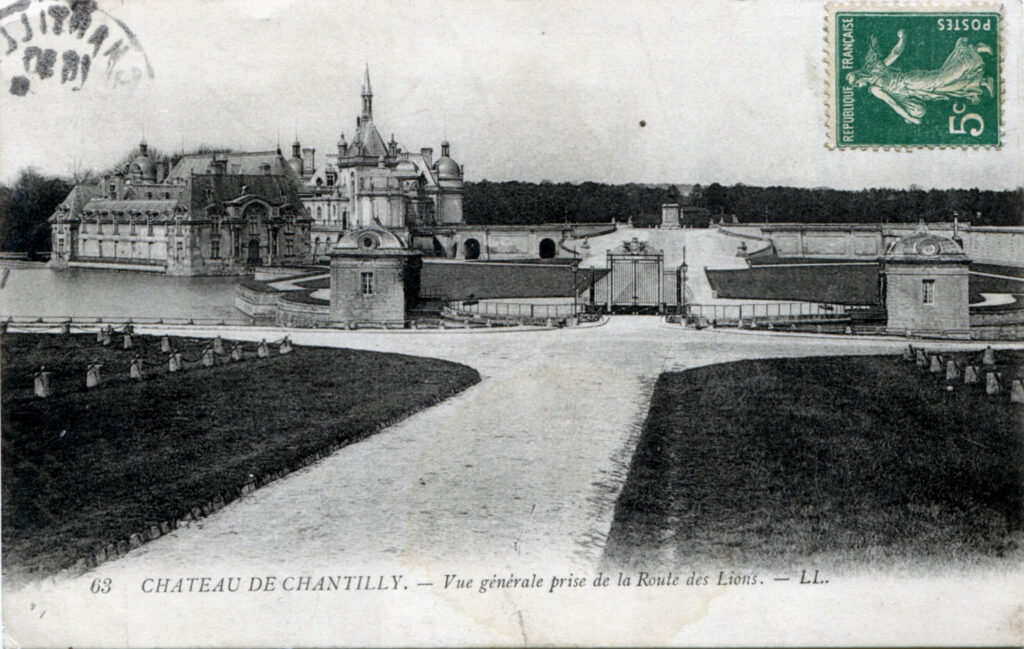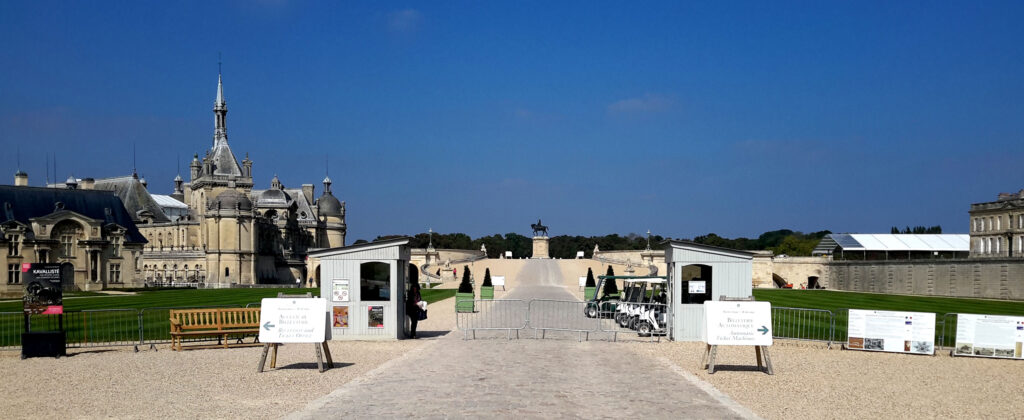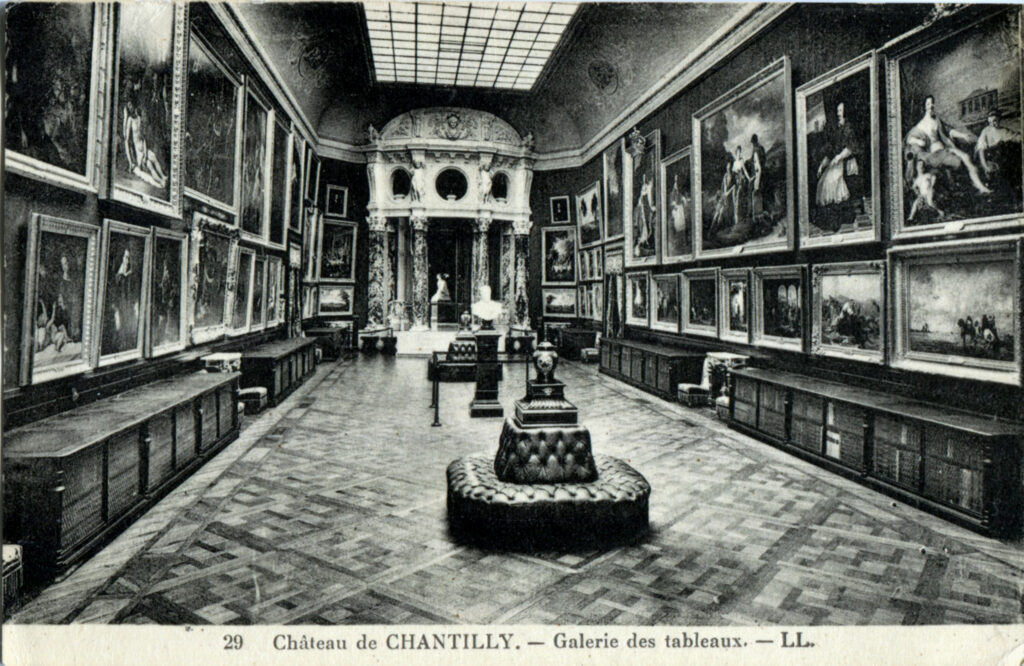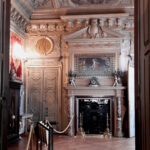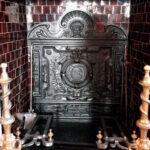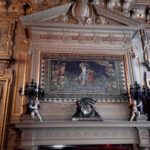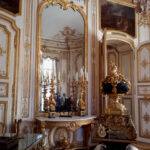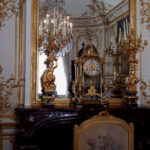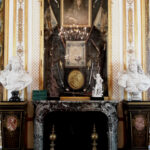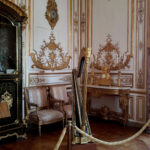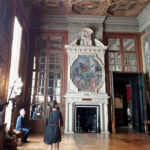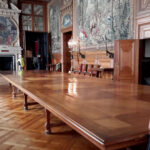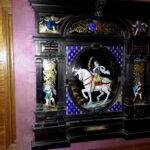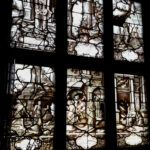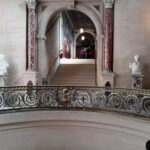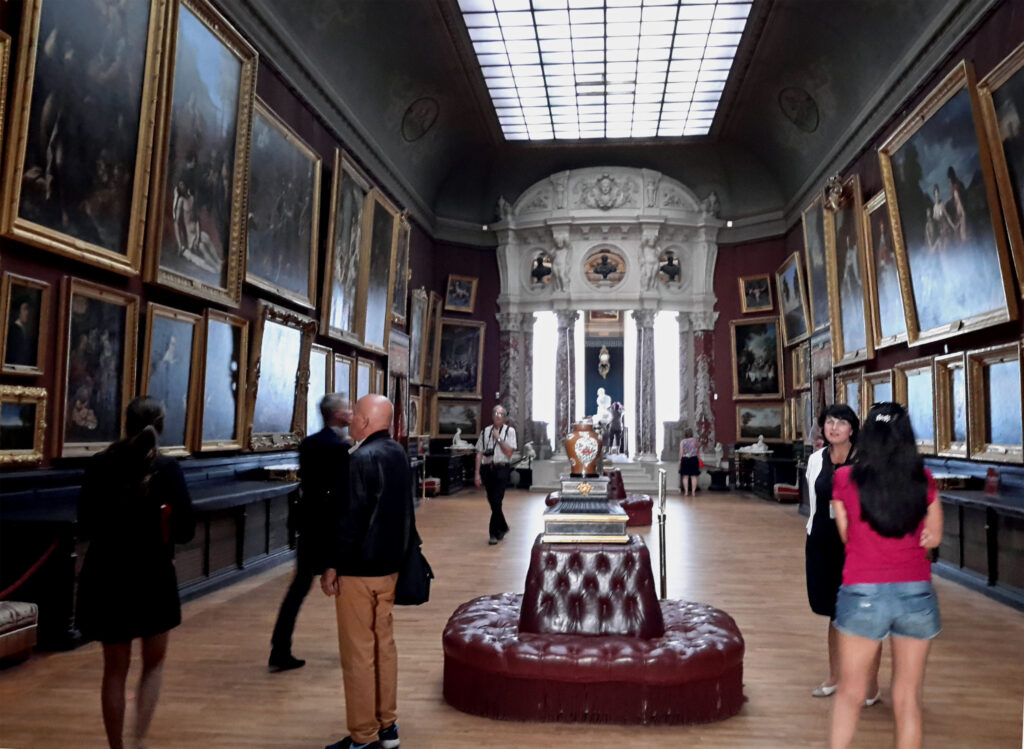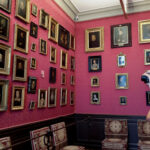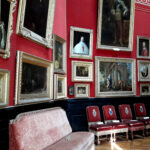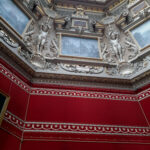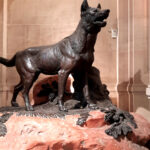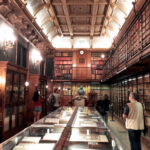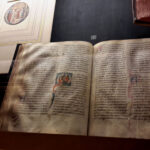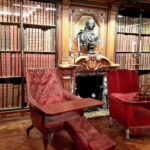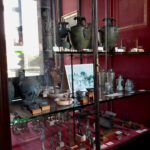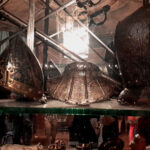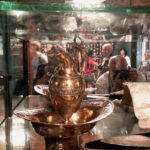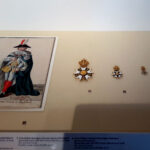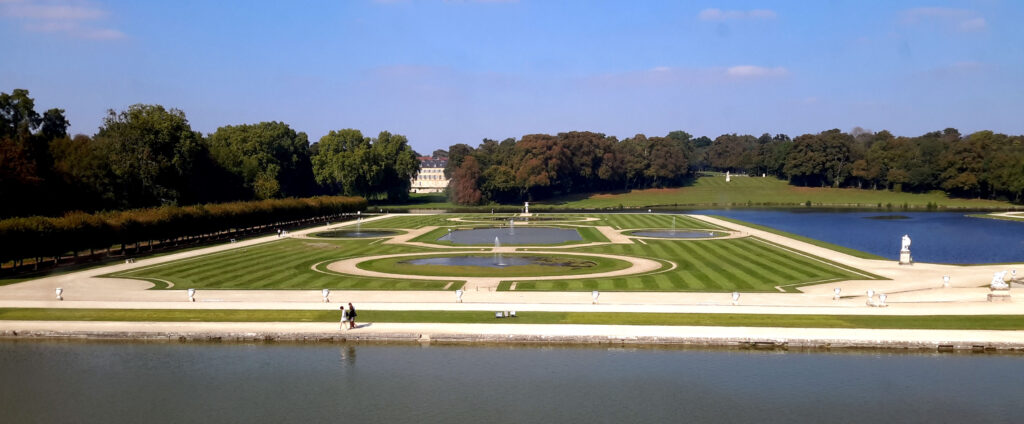Chantilly Castle (Chateau de Chantilly)
The history of the castle and the estate begins in 1484, when Chantilly becomes the property of the Montmorency family. The greatest contribution to the architecture of the estate was made by the constable Anne de Montmorency, whose equestrian statue towers in front of the palace. The estate and the castle were inherited in various branches of the same family, despite the fact that in 1632 the grandson of the constable, Henry II de Montmorency, was put to death, and in 1804 the Duke of Enghien was shot. After the death of the last Prince of Condé in 1830, the Chateau de Chantilly went to the Duke of Omal; who bequeathed it, together with a precious library and art gallery, to the French Institute.
Photo: Sights of France on old postcards. Photographer L.L. Stamp and postage stamp. Collection of the Union of Taxi Drivers in Paris and Nice. Chantilly Castle, general view from the road of Lions.
World War I and Chantilly
The Manor and the castle looked about the same during the First World War, as on the postcard above. During this “Great War” Chantilly was the country residence of Marshal Joseph Joffre. The most important meetings and conferences of the Allies were held in the castle, plans for coordinated actions of the parties were discussed and plans for strategic operations on the Western Front and even on the Eastern Front were developed.
The Chantilly Conferences were a series of three meetings held between 1915 and 1916 by the Allied Powers. They went down in history under the name of Chantilly, where the meetings took place.
Held on July 7, 1915, the first inter-allied military conference was convened in the Grand Quartier Général GQG shortly after Italy entered the war against the Central Powers. Representatives were present from Great Britain (including Commander-in-Chief Sir John French and Chief of the Imperial General Staff William Robertson), France (Alexandre Millerand, Minister of War and Commander-in-Chief Joseph Joffre), Belgium, Italy, Serbia and Russia. Joffre told the delegates that concerted, coordinated action would create the most favorable conditions for an Allied victory. No specific commitments were agreed upon at the end of the conference. A later conference at Chantilly, about five months later, was more ambitious in its aims and led to an Allied commitment to launch an offensive if the Central Powers threatened any of the Allies.
From 8 to 12 December 1915, an Allied military planning conference was held at GQG, Joffre’s headquarters in Chantilly, with military representatives from the Allied Powers, France, Britain, Russia, Serbia and Italy, to form a common strategy for 1916 against the Central Axis. . Composition and powers. The British representatives were Commander-in-Chief Sir John French and Sir Archibald Murray. General Carlo Porro represented Italy. Joffre suggested, and everyone agreed, that the offensive of the Allied armies on the Western Front should be launched simultaneously or quickly enough to prevent the Central Powers from transferring reserves from one front to another. A coordinated offensive was planned to begin as soon as possible, with localized limited attacks in between to further weaken the enemy, weather permitting.
From March 12 to March 13, 1916, a plan for synchronized attacks was approved at the second meeting in Chantilly, Russia should start the offensive around May 15, and the rest to join in about two weeks. Serb troops were re-equipped and were to be transferred to Thessaloniki, the Italian army in Albania, the Franco-British East in Macedonia for an indefinite period would maintain the threat of attack. The delegates also agreed to an increased blockade of the Central Powers.
From 15 to 16 November 1916, the generals met again at Chantilly and the political leaders met in Paris before a joint meeting. In the memorandum, Joffre wrote that the combined offensive had shaken the Central Powers in 1916 and that the spring offensive should be used in France and against Bulgaria. Joffre suggested that the Russian army could be re-equipped with weapons and equipment sent from the west to take Bulgaria out of the war. Joffre wanted the offensive on the Western Front to be larger than in 1916 and to start in February to prevent the Central Powers from getting ahead of the Allies as they had in 1916, but the British argued that they could not be ready before May, and the Russian and Italian delegations followed suit. At the conclusion of the meeting, everyone agreed on a plan that would have a decisive effect, but the deadline in February was unattainable. Considerable time was devoted to discussing the Balkans and the defeat of Bulgaria by attacks from the east and south, and it was decided to increase the forces in Thessaloniki, provided that troops were not diverted from France. The military leaders met with the politicians and there was some disagreement about having 23 divisions in Thessaloniki. Aristide Briand said that both meetings came to the same conclusion, but David Lloyd George stated that it was “little better than farce”. Before detailed planning could begin, Joffre was fired and replaced by Robert Nivelle, who replaced the entire plan for 1917 with a more ambitious one.
Chantilly (French: Château de Chantilly) is the manor and the castle from the era of the “Old order” according to French traditions of division into historical periods. It is located in the suburbs of Paris in the commune of Chantilly (Department of the Oise), in the valley of the Nonette River, a tributary of the Oise River.
A little history of the manor and the castle
The first buildings in this area, which was then called Cantilius, are known even under Roman rule in the Gallo-Roman era. In the X century there was already a real castle, destroyed by the middle of the XIV century. At the end of the 14th century, French Chancellor Pierre de Orgemont built a new castle here. In the middle of the XV century. The widow Marguerite de Orgemont marries the Baron de Montmorency. The Montmorency family begins to be the master here for two centuries. The grandson of Marguerite de Orgemont, the constable Anne de Montmoronsy hires the architect Pierre Chambige, who builds a real fortified castle here in the style and under the influence of the Italian campaigns of the constable. Being a great connoisseur of art and a patron of the arts, Anne de Montmorency built another castle, inviting the famous masters Jean Boulan, Francois Clue, Bernard Palissy, Leonard Limousin, Jean Goujon. The new palace, which received the name “Small Castle” or Capitanary, was filled with works of art, sculptures and paintings, decorative furniture and elegant carpets. After several years of disgrace, the diplomat and commander Anne de Montmorency again participated in the battles, but was mortally wounded at the battle of Saint-Denis and died at the age of 74. His youngest son was married three times and had a beautiful daughter, Charlotte, to whom even King Henry IV was not indifferent. Charlotte married the Prince of Conde and they had a son who became an admiral very early, and already at the age of 35 a marshal of France. His escort consisted of three dozen pages in silk suits with gold embroidery and hundreds of knights of aristocratic origin. At the insistence of Queen Marie Medici, he was married to the beautiful Marie-Felicia Orsini (“Silvia”), but was implicated in the rebellion of Gaston of Orleans and was executed in Toulouse on October 30, 1632. Montmorency’s property was requisitioned by Louis XIII. The estate of Chantilly was donated by Anna of Austria to her mother, Charlotte de Montmorency, Princess of Conde (Duchess of Angouleme) after the military victory of the Duke of Enghien – the Great Conde. The great Conde embellished the park by inviting La Quenteny and Le Notre. This park began to serve as a venue for celebrations, which were even attended by King Louis XIV himself. Subsequent generations of Conde also made changes to the buildings.
1770 – Enghien Castle was built in honor of the duke’s son, who was later shot by Napoleon in the Bois de Vincennes.
1782 – Prince Conde receives the future Russian Emperor Paul I and his wife, nee Princess Dorothea of Württemberg, who travel under the names of Count and Countess of the North. For this hospitable reception, Emperor Paul I later gives shelter to the owners of Chantilly who fled from the revolution and even to his guards.
1830 The last of the Princes of Conde, Louis-Henri-Joseph Conde, the father of Louis-Antoine-Henri Conde, who was shot by Napoleon, dies in Saint-Laye. The Duke of Omal becomes the heir of the family, who builds a Grand Castle in Chantilly and restores the estate under the guidance of the architect Domé.
1886 – The Duke of Omal donates the estate, castle and collections to the Institute of France.
At the moment, the castle, park and art collections are world heritage and are available to visitors.
Condé Museum (French: Musée Condé)
The Conde Museum is located in the Château de Chantilly in what used to be large and small apartments built in the 18th and 19th centuries under the Prince of Conde and the Duke of Omal.
Photo gallery of Chantilly castle, reviews and tips
- Castle inside, real palace
- Fireplace with iron decoration
- Fireplace decoration, oil painting
- Mirror and candlesticks
- Classic antique – beautiful clock
- Sculptures and busts
- Antique furniture: wardrobe, armchairs
- Another hall and another fireplace
- Large table for international conferences in the first world war
- Original royal decorations with a rider
- Stained glass windows with historical scenes
- Sculptures and busts in the corridors and on the stairs
Condé Museum and its collections
The collection contains more than 500 paintings by famous masters, 300 miniatures, 689 drawings by famous artists, 500 painted portraits of which 400 were painted in the 16th century, 500 watercolor portraits of Carmonel, 600 portraits of Rafe, 3000 prints, bronze statues, collections of ceramics, rare coins and medals. . Here are the works of the masters Raphael, Botticelli, Filippo Lippi, Perugino, Titian, Salvador Rosa, Rubens, Van Dyck, Corot, Durer … There is a large library consisting of 14,000 volumes of rare books, 1,400 manuscripts, 5,000 prints, many letters and archives. There is also a collection of carpets and jewelry, including the famous “pink diamond”
The Musée Condé’s painting collection is considered one of the most significant collections in France. Includes mainly works by Italian and French artists: Fra Angelico, Raphael, Poussin, Watteau, Ingres.
The drawing cabinet has 2,500 items.
The museum’s library contains 1,500 manuscripts, of which 200 are illuminated. Among the famous manuscripts is The Magnificent Book of Hours by the Duke of Berry.
The museum’s collection also includes engravings, portrait miniatures, sculptures, a collection of works of ancient art, photographs and objects of decorative art – furniture and porcelain.
In total, the museum has 1,000 paintings, 2,500 drawings, 2,500 engravings, 30,000 books, including more than 12,000 printed publications, 1,500 manuscripts. Numerous engravings and paintings by Botticelli, Clouet, Poussin and other old masters.
According to the will of the Duke of Omalsky, not a single item from his collections can be taken outside the Chantilly estate and the permanent exhibition should not be changed. The halls of the museum now look the same as in the year of its foundation in 1898.
The museum receives about 250,000 visitors annually. During the year, the museum hosts 4 temporary exhibitions, where you can see some of the works stored in the museum’s storerooms.
- Collection of small size oil paintings
- Medium Format Paintings
- Paintings and sculptures under the ceiling
- Sculptures with animals
- Library of old rare books and engravings
- Antiquarian books with drawings
- Artistic illustrations
- Comfortable armchairs with reading stand
- Collection of various antiques, dishes, figurines of warriors
- Knights armor, swords, sabers
- Fine tableware, jugs, spatula
- Awards – Order of the Legion of Honor in Gold
Chantilly Manor Park
French Garden André Le Nôtre (XVII century): amphitheaters and fountains, cascades. Little Park (early 18th century): Sylvia’s house and pond. Anglo-Chinese Garden (late 18th century): small canals, farm houses and a restaurant. English Garden (early 19th century): Love Island, Temple of Venus, Lake of Swans and Beauvais Fountains.
Chantilly Manor and Park.
Here, during a tour of the surroundings of Chantilly Castle, you can see a terrace with stone chimeras of the great Cousteau. Behind the royal bridge, shady alleys begin next to Enghien Castle and St. Paul’s Chapel. Behind the pond is an alley and the house of Sylvia, the wife of the marshal of France. Later, a rotunda overlooking the pond was added to the house that the Great Conde built. Along alleys and bridges, past statuary groups and statues, and even past a holiday village, our tour continues past pools and canals, past the English Garden to the Great Stables.
Chantilly Manor and the First World War
Chantilly is located 40 kilometers north of Paris on a spacious area of 7800 hectares of land, among one of the largest Three forests (Chantilly, Alette, Ermenoville). During the “gallant age” the famous hippodrome was founded here, where races are still held. In 1719 the building of the stables was founded by the Prince of Condé. Now the Horse Museum is open in this building. The presence of such infrastructure and convenient location made Chantilly during the First World War the country residence of Marshal Joseph Joffre. Here the most important meetings and conferences of the allies were held, plans for coordinating actions were discussed and plans for strategic operations of the First World War were developed.
Large stables or horse museum.
An architectural monument of the 18th century, built by Jean Aubert for the Duke of Bourbon, Minister of King Louis XV. The stable is designed for 240 horses. There is an arena with arcades and sculptures, a fountain and a pediment above the entrance. Hippodrome and race track. Not a bad tourist place for our Cossacks and sports fans, which the president himself is engaged in.
Chantilly Castle tour from Paris
From the hotel or Charles de Gaulle airport by a car (minibus) with an English-speaking guide, cost (for a standard 4 hours) / car class:
Note that a visit to Chantilly can be combined with a one-day trip to another site, such as the Manor of Claude Monet in Givirny. The Chantilly tour is well combined with a trip to the battlefields of the First World War on the Marne, in Champagne (Fort Pompelle and Automobile Museum in Reims) or Citadel Verdun. We also recommend visiting the wonderful museums in Meaux and Saumur (Loire Valley) for the history of the First World War.

